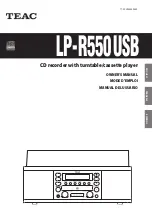
8
Handling Cassette Tape
CAUTION:
<
Do not open a cassette or pull out the tape.
<
Do not touch the tape surface.
<
Do not use cassette tapes in areas with high temperatures and
humidity.
Storage precautions
<
Keep cassette tapes away from magnets or magnetized items
because they may cause noise or erase recorded contents.
<
Do not leave cassette tapes in dusty places.
<
Do not store cassette tapes in areas with high temperatures and
humidity.
Cassette tapes to avoid
The following cassette tapes may prevent the unit from
performing normal operation or functions. The tape of such
cassette tapes may get caught and causing unexpected
problems.
Cassette tapes with poor form accuracy
Deformed cassettes, or cassettes whose tape does not track
properly, or which generate abnormal noise during fast-
forwarding or rewinding.
Long-recording tapes
Tapes for recording 90 minutes or longer sometimes get caught
by the capstan because they are extremely thin and stretch easily.
Avoid using them as much as possible.
Slackening of tapes
Slackened tapes may get caught by the capstan or other parts.
Eliminate slack by using a pencil or alike before use.
Tape types
There are several types of cassette tapes.
<
When playing a normal tape (type I), set the TAPE switch by the
turntable to NORMAL. When playing a chrome tape (type II) or
metal tape (type IV), set the switch to HIGH.
Cleaning and demagnetizing the cassette deck
A dirty head causes poor sound quality or sound skip. Dirt on the
tape tracking roller may catch the tape. Clean the head, pinch
roller, and capstan with a cotton applicator dampened with a
commercially available cleaning solution about every ten hours
of use.
When the head is magnetized, it increases noise and hinders the
unit from transmitting high notes. When these problems occur,
demagnetize the head using a commercially available head
eraser.
Capstan
Record/playback head
Pinch roller
Do not place a cassette tape in the cassette holder of the unit
until the cleaning solution on the head dries.
Metal (Type IV)
Chrome (Type II)
Normal (Type I)
Automatic tape-type
detection holes









































